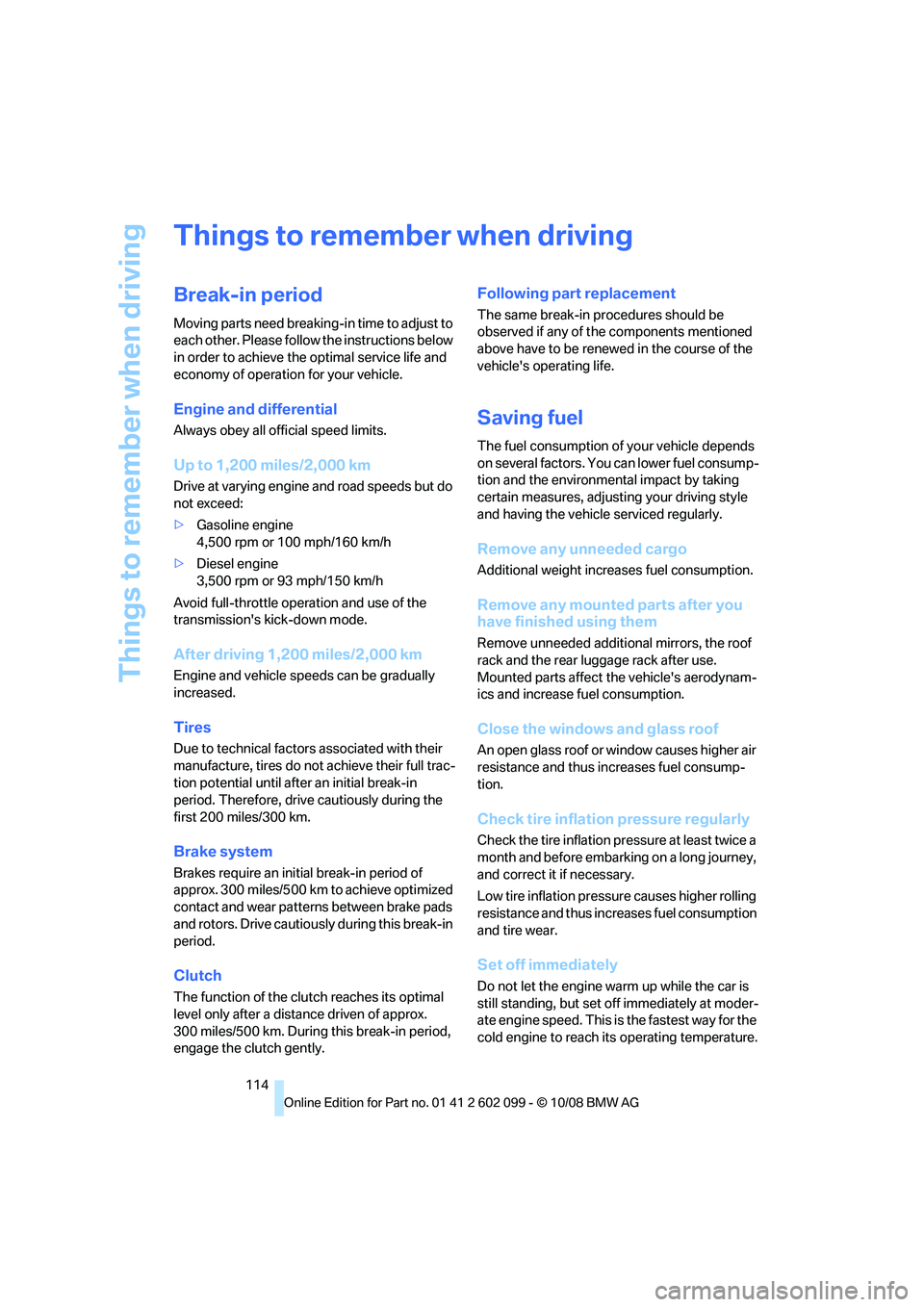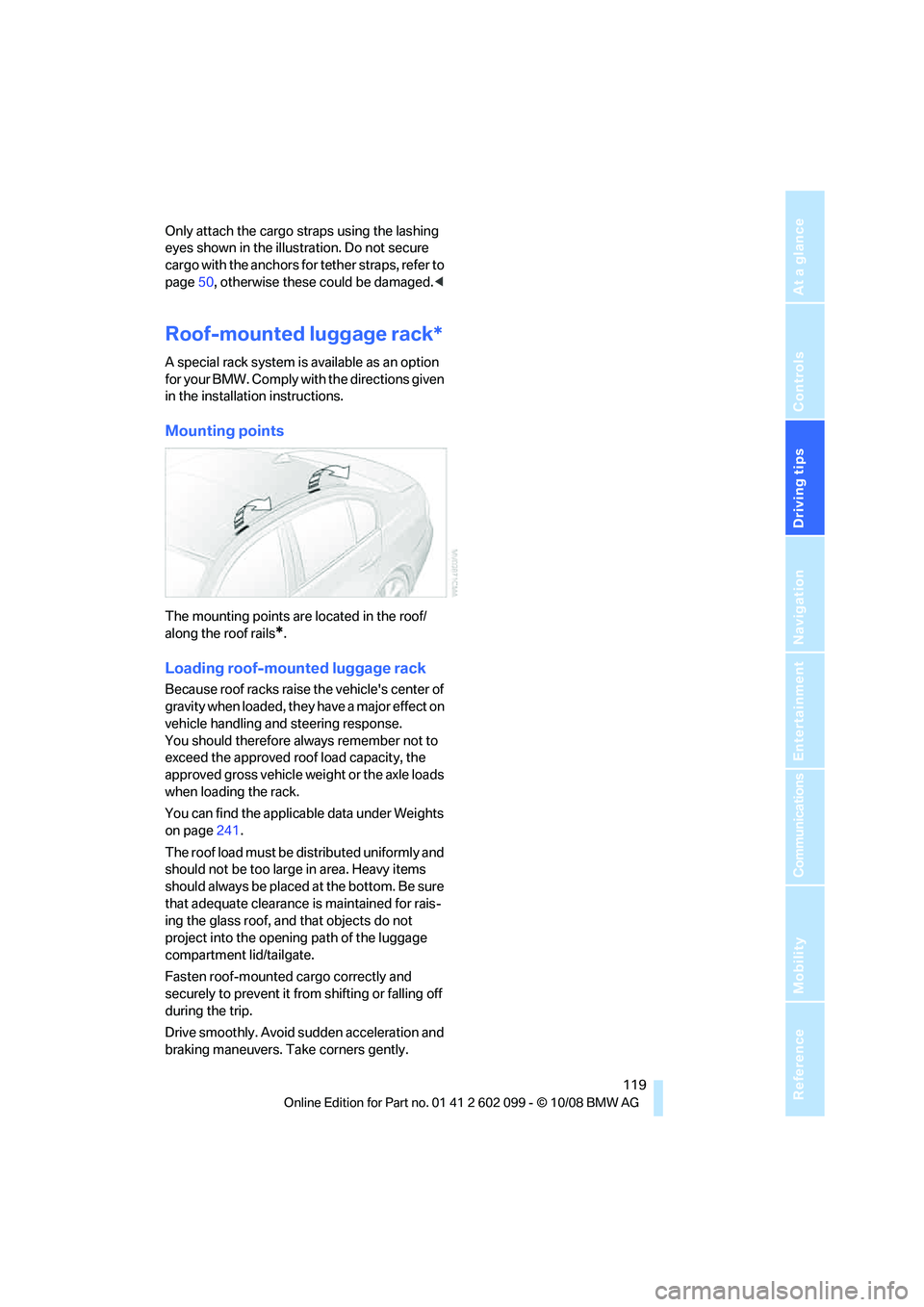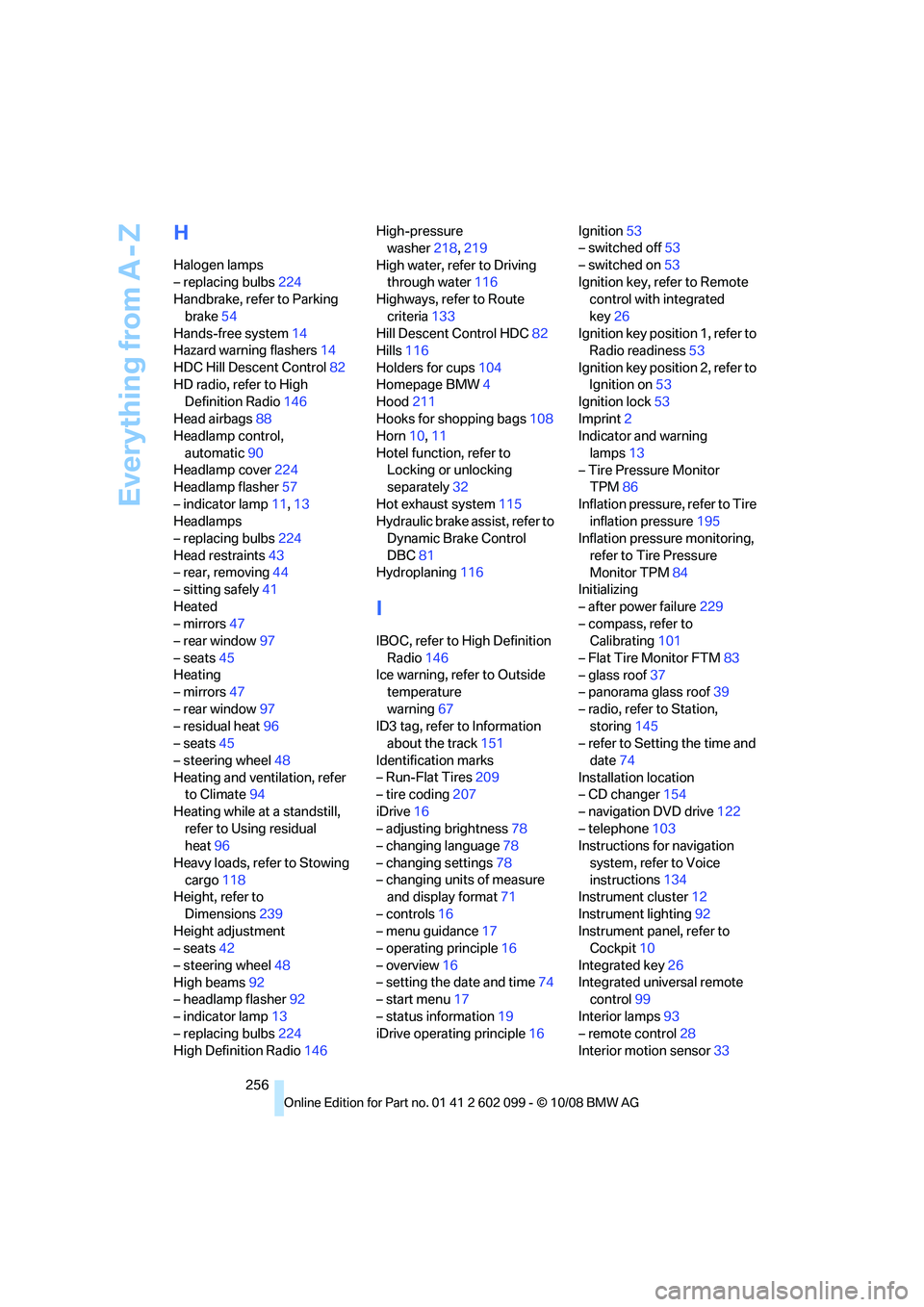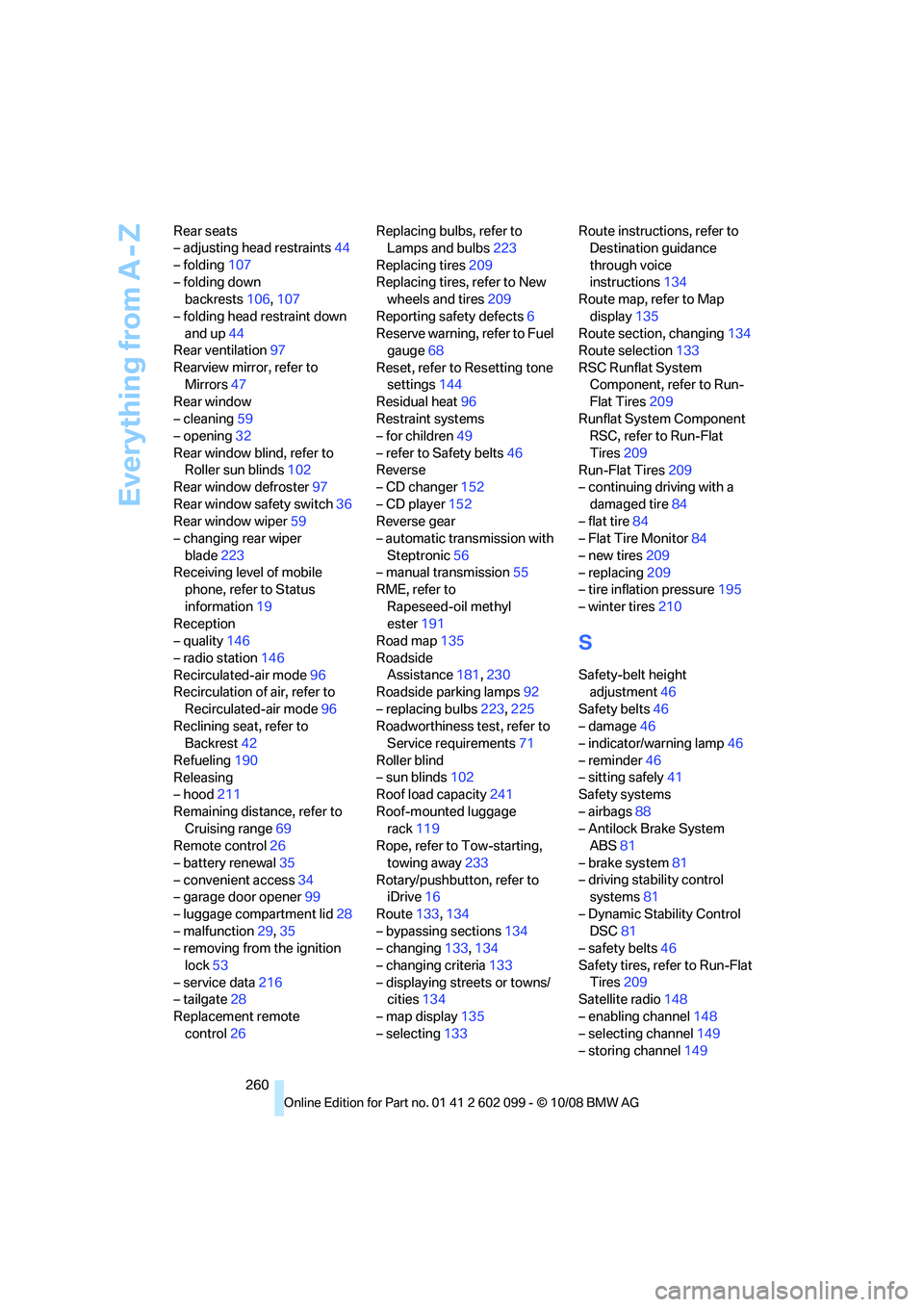2009 BMW 328I roof rack
[x] Cancel search: roof rackPage 17 of 268

At a glance
15Reference
Controls
Driving tips
Communications
Navigation
Entertainment
Mobility
1Microphone for voice activation system*
and for telephone in hands-free mode*
2SOS: initiating an Emergency Request
call
*230
3 Reading lamps 93
4 Glass roof/panorama glass roof
*37
5 Interior lamps 93
6 Passenger airbag status lamp
*89
7 Control Display 16
8 Hazard warning flashers
9 Dynamic Traction Control DTC 81
10 Central locking system 30
11 Automatic climate control
12 CD/DVD drive 150
13 Changing the audio and entertainment
sources
14 Selecting AM or FM waveband 15
Changing
>Radio station 145
> Track 150
17 Controller 16
Can be turned, pressed, or moved in four
directions
18 Buttons on the controller 16
Selecting menus directly
19 Programmable memory keys 20
20 Switching audio sources on/off and adjust-
ing volume 142
21 Ejecting CD/DVD 150
Air distribution to the
windshield
95
Air distribution to the upper body
area 95
Air distribution to the footwell 95
Automatic air distribution and flow
rate 95
Cooling function 96
Automatic recircul ated-air control
AUC 96
Recirculated-air mode 96
Maximum cooling 95
Residual heat mode 96
Air flow rate 95
Defrosting windows 96
Rear window defroster 97
16
Heated seats*45
Park Distance Control PDC
*80
Sedan:
Roller sun blind
*102
Hill Descent Control HDC
*82
ba8_E9091_cic.book Seite 15 Mittwoch, 29. Oktober 2008 2:59 14
Page 25 of 268

At a glance
23Reference
Controls
Driving tips
Communications
Navigation
Entertainment
Mobility
Using alternative commands
There are often a number of commands to run a
function, e.g.:
Calling up functions immediately via
short commands
Short commands enable you to perform certain
functions immediately, irrespective of which
menu item is selected, refer to page243.
Example: selecting the track of a CD
1.If necessary, switch on entertainment audio
output.
2. Press the button on the steering wheel.
Setting the voice dialog
You can set whether the system should use the
standard dialog or a shorter variant. In the
shorter variant of the voice dialog, the prompts
and responses from the system are abbrevi-
ated.
1."Settings"
2. "Language/Units"
3. "Speech mode:"
4. To select the setting:
>"Default"
> "Short"
Notes
For information on voice control of the
telephone, refer to page 175.<
For voice commands, bear in mind the follow-
ing:
> Do not use the voice activation system to
initiate an Emergency Request. In stressful
situations, the voice and vocal pitch can
change. This can unne cessarily delay the
establishment of a telephone connection.
> Pronounce the commands and digits
smoothly and at normal volume, avoiding
excessive emphases and pauses. This also
applies when spelling out and saying a full
word during destination entry.
> When selecting a radio station, use the
standard pronunciation of the station name.
> For entries in the voice-activated phone
book, only use names in the language of the
voice activation system and no abbrevia-
tions.
> Keep the doors, windows and glass roof/
panorama glass roof closed to prevent
interference from outside noise.
> Avoid ambient noise in the vehicle while
speaking.
{
Radio on } or {Radio }
3. Select the music track, e.g.:
{CD track 4 }
System says:
{{ Track 4 }}
ba8_E9091_cic.book Seite 23 Mittwoch, 29. Oktober 2008 2:59 14
Page 116 of 268

Things to remember when driving
114
Things to remember when driving
Break-in period
Moving parts need breaking-in time to adjust to
each other. Please follow the instructions below
in order to achieve the optimal service life and
economy of operation for your vehicle.
Engine and differential
Always obey all official speed limits.
Up to 1,200 miles/2,000 km
Drive at varying engine and road speeds but do
not exceed:
> Gasoline engine
4,500 rpm or 100 mph/160 km/h
> Diesel engine
3,500 rpm or 93 mph/150 km/h
Avoid full-throttle operation and use of the
transmission's kick-down mode.
After driving 1,200 miles/2,000 km
Engine and vehicle speeds can be gradually
increased.
Tires
Due to technical factors associated with their
manufacture, tires do no t achieve their full trac-
tion potential until afte r an initial break-in
period. Therefore, drive cautiously during the
first 200 miles/300 km.
Brake system
Brakes require an initial break-in period of
approx. 300 miles/500 km to achieve optimized
contact and wear patterns between brake pads
and rotors. Drive cautiously during this break-in
period.
Clutch
The function of the clut ch reaches its optimal
level only after a distan ce driven of approx.
300 miles/500 km. During this break-in period,
engage the clutch gently.
Following part replacement
The same break-in procedures should be
observed if any of the components mentioned
above have to be renewe d in the course of the
vehicle's operating life.
Saving fuel
The fuel consumption of your vehicle depends
on several factors. You can lower fuel consump-
tion and the environmental impact by taking
certain measures, adjusting your driving style
and having the vehicle serviced regularly.
Remove any unneeded cargo
Additional weight incr eases fuel consumption.
Remove any mounted parts after you
have finished using them
Remove unneeded additional mirrors, the roof
rack and the rear luggage rack after use.
Mounted parts affect th e vehicle's aerodynam-
ics and increase fuel consumption.
Close the windows and glass roof
An open glass roof or window causes higher air
resistance and thus increases fuel consump-
tion.
Check tire inflation pressure regularly
Check the tire inflation pr essure at least twice a
month and before embarking on a long journey,
and correct it if necessary.
Low tire inflation pressure causes higher rolling
resistance and thus increases fuel consumption
and tire wear.
Set off immediately
Do not let the engine wa rm up while the car is
still standing, but set off immediately at moder-
ate engine speed. This is the fastest way for the
cold engine to reach its operating temperature.
ba8_E9091_cic.book Seite 114 Mittwoch, 29. Oktober 2008 2:59 14
Page 121 of 268

Driving tips
119Reference
At a glance
Controls
Communications
Navigation
Entertainment
Mobility
Only attach the cargo straps using the lashing
eyes shown in the illustration. Do not secure
cargo with the anchors for tether straps, refer to
page 50, otherwise these could be damaged. <
Roof-mounted luggage rack*
A special rack system is available as an option
for your BMW. Comply with the directions given
in the installation instructions.
Mounting points
The mounting points are located in the roof/
along the roof rails
*.
Loading roof-mounted luggage rack
Because roof racks raise the vehicle's center of
gravity when loaded, they have a major effect on
vehicle handling and steering response.
You should therefore always remember not to
exceed the approved roof load capacity, the
approved gross vehicle weight or the axle loads
when loading the rack.
You can find the applicab le data under Weights
on page 241.
The roof load must be distributed uniformly and
should not be too large in area. Heavy items
should always be placed at the bottom. Be sure
that adequate clearance is maintained for rais-
ing the glass roof, and that objects do not
project into the opening path of the luggage
compartment lid/tailgate.
Fasten roof-mounted cargo correctly and
securely to prevent it from shifting or falling off
during the trip.
Drive smoothly. Avoid sudden acceleration and
braking maneuvers. Ta ke corners gently.
ba8_E9091_cic.book Seite 119 Mittwoch, 29. Oktober 2008 2:59 14
Page 258 of 268

Everything from A - Z
256
H
Halogen lamps
– replacing bulbs224
Handbrake, refer to Parking
brake 54
Hands-free system 14
Hazard warning flashers 14
HDC Hill Descent Control 82
HD radio, refer to High Definition Radio 146
Head airbags 88
Headlamp control,
automatic 90
Headlamp cover 224
Headlamp flasher 57
– indicator lamp 11,13
Headlamps
– replacing bulbs 224
Head restraints 43
– rear, removing 44
– sitting safely 41
Heated
– mirrors 47
– rear window 97
– seats 45
Heating
– mirrors 47
– rear window 97
– residual heat 96
– seats 45
– steering wheel 48
Heating and ventilation, refer to Climate 94
Heating while at a standstill, refer to Using residual
heat 96
Heavy loads, refer to Stowing cargo 118
Height, refer to
Dimensions 239
Height adjustment
– seats 42
– steering wheel 48
High beams 92
– headlamp flasher 92
– indicator lamp 13
– replacing bulbs 224
High Definition Radio 146High-pressure
washer 218,219
High water, refer to Driving through water 116
Highways, refer to Route
criteria 133
Hill Descent Control HDC 82
Hills 116
Holders for cups 104
Homepage BMW 4
Hood 211
Hooks for shopping bags 108
Ho
rn 10, 11
Hotel function, refer to Locking or unlocking
separately 32
Hot exhaust system 115
Hydraulic brake assist, refer to Dynamic Brake Control
DBC 81
Hydroplaning 116
I
IBOC, refer to High Definition
Radio 146
Ice warning, refer to Outside temperature
warning 67
ID3 tag, refer to Information about the track 151
Identification marks
– Run-Flat Tires 209
– tire coding 207
iDrive 16
– adjusting brightness 78
– changing language 78
– changing settings 78
– changing units of measure and display format 71
– controls 16
– menu guidance 17
– operating principle 16
– overview 16
– setting the date and time 74
– start menu 17
– status information 19
iDrive operating principle 16Ignition
53
– switched off 53
– switched on 53
Ignition key, refer to Remote control with integrated
key 26
Ignition key position 1, refer to Radio readiness 53
Ignition key position 2, refer to Ignition on 53
Ignition lock 53
Imprint 2
Indicator and warning
lamps 13
– Tire Pressure Monitor TPM 86
Inflation pressure, refer to Tire inflation pressure 195
Inflation pressure monitoring,
refer to Tire Pressure
Monitor TPM 84
Initializing
– after power failure 229
– compass, refer to Calibrating 101
– Flat Tire Monitor FTM 83
– glass roof 37
– panorama glass roof 39
– radio, refer to Station, storing 145
– refer to Setting the time and
date 74
Installation location
– CD changer 154
– navigation DVD drive 122
– telephone 103
Instructions for navigation
system, refer to Voice
instr
uctions 134
Instrument cluster 12
Instrument lighting 92
Instrument panel, refer to Cockpit 10
Integrated key 26
Integrated universal remote control 99
Interior lamps 93
– remote control 28
Interior motion sensor 33
ba8_E9091_cic.book Seite 256 Mittwoch, 29. Oktober 2008 2:59 14
Page 259 of 268

Reference 257
At a glance
Controls
Driving tips
Communications
Navigation
Entertainment
Mobility
Interior rearview mirror48
– automatic dimming
feature 48
– compass 101
Interlock, refer to Disengaging
the remote control 55
Intermittent mode of the wipers 58
Intersection, entering, navigation 124
iPod, connecting, refer to
AUX-IN port 161
iPod, connecting, refer to
USB-audio interface 162
J
Jacking points228
Joystick, refer to iDrive 16
Jumpering, refer to Jump starting 231
Jump starting 231
K
Key, refer to Integrated key/
remote control 26
Keyless go, refer to
Convenient access 34
Keyless opening and closing, refer to Convenient
access 34
Key Memory, refer to Personal Profile 26
Kick-down 56
– automatic transmission with Steptronic 56
Knock control 191
L
Lamps
– automatic headlamp
control 90
– parking lamps/low beams 90
Lamps and bulbs, replacing
bulbs 223
Language, changing on Control Display 78 Lap-and-shoulder belt, refer
to Safety belts 46
Lashing eyes, refer to Securing cargo 118
Last destinations 126
LATCH child-restraint fixing system 50
Leather care 220
LED Light-emitting diodes 223
Length, refer to
Dimensions 239
License plate lamp, replacing
bulb 228
Light-alloy wheels 219
Light-emitting diodes
LED 223
Lighter 104
– connecting electrical
appliances 105
Lighting
– instruments 92
– lamps and bulbs 223
– vehicle, refer to Lamps 90
Light switch 90
Limit, refer to Speed limit 77
Load 118
Load securing equipment,
refer to Securing cargo 118
Lock buttons, doors, refer to Locking 30
Locking
– adjusting confirmation signal 28
– from inside 30
– from outside 28
– without remote control, refer
to Convenient access 34
Locking and unlocking doors
– confirmation signals 28
– from inside 30
– from outside 27
Longlife oils
– alternative oil types 215
– approved engine oils 215
Low-beam headlamps 90
– automatic 90
Low beams
– replacing bulbs 224Lower back support, refer to
Lumbar support 43
Luggage compartment lid 30
– convenient access 35
– emergency release 32
– locking or unlocking separately 32
– open
ing from inside 30
– opening from outside 31
– remote control 28
Luggage rack, refer to Roof-
mounted luggage rack 119
Lumbar support 43
LW, waveband 145
M
M+S tires, refer to Winter
tires 210
Maintenance, refer to Service Booklet
Maintenance system 216
Malfunction
– automatic transmission with Steptronic 57
– luggage compartment lid 31
– tires 84
Malfunction warnings, refer to
Check Control 75
Manual car wash 219
Manual mode, automatic
transmission with
Steptronic 56
Manual operation
– door lock 29
– driver's door 29
– fuel filler door 190
– glass roof 37
– luggage compartment lid 31
– panorama glass roof 39
– transmission lock, automatic transmission 57
Manual transmission 55
Map display 135
Map for navigation
– changing scale 135
– entering destination 128
ba8_E9091_cic.book Seite 257 Mittwoch, 29. Oktober 2008 2:59 14
Page 262 of 268

Everything from A - Z
260
Rear seats
– adjusting head restraints
44
– folding 107
– folding down backrests 106,107
– folding head restraint down and up 44
Rear ventilation 97
Rearview mirror, refer to Mirrors 47
Rear window
– cleaning 59
– opening 32
Rear window blind, refer to Roller sun blinds 102
Rear window defroster 97
Rear window safety switch 36
Rear window wiper 59
– changing rear wiper
blade 223
Receiving level of mobile phone, refer to Status
information 19
Reception
– quality 146
– radio station 146
Recirculated-air mode 96
Recirculation of air, refer to
Recirculated-air mode 96
Reclining seat, refer to Backrest 42
Refueling 190
Releasing
– hood 211
Remaining distance, refer to Cruising range 69
Remote control 26
– battery renewal 35
– convenient access 34
– garage door opener 99
– luggage compartment lid 28
– malfunction 29,35
– removing from the ignition
lock 53
– service data 216
– tailgate 28
Replacement remote control 26 Replacing bulbs, refer to
Lamps and bulbs 223
Replacing tires 209
Replacing tires, refer to New wheels and tires 209
Reporting safety defects 6
Reserve warning, refer to Fuel gauge 68
Reset, refer to Resetting tone settings 144
Residual heat 96
Restraint systems
– for children 49
– refe
r to Safety belts 46
Reverse
– CD changer 152
– CD player 152
Reverse gear
– automatic transmission with
Steptronic 56
– manual transmission 55
RME, refer to
Rapeseed-oil methyl
ester 191
Road map 135
Roadside Assistance 181,230
Roadside parking lamps 92
– replacing bulbs 223,225
Roadworthiness test, refer to Service requirements 71
Roller blind
– sun blinds 102
Roof load capacity 241
Roof-mounted luggage rack 119
Rope, refer to Tow-starting,
towing away 233
Rotary/pushbutton, refer to iDrive 16
Route 133,134
– bypassing sections 134
– changing 133,134
– changing criteria 133
– displaying streets or towns/ cities 134
– map display 135
– selecting 133 Route instructions, refer to
Destination guidance
through voice
instructions 134
Route map, refer to Map
display 135
Route section, changing 134
Route selection 133
RSC Runflat System Component, refer to Run-
Flat Tires 209
Runflat System Component RSC, refer to Run-Flat
Tires 209
Run-Flat Tires 209
– continuing driving with a
damaged tire 84
– flat tire 84
– Flat Tire Monitor 84
– new tires 209
– replacing 209
– tire inflation pressure 195
– winter tires 210
S
Safety-belt height
adjustment 46
Safety belts 46
– damage 46
– indicator/warning lamp 46
– reminder 46
– sitting safely 41
Safety systems
– airbags 88
– Antilock Brake System ABS 81
– brake system 81
– driving stability control systems 81
– Dynamic Stability Control DSC 81
– safety belts 46
Safety tires, refer to Run-Flat Tires 209
Satellite radio 148
– enabling channel 148
– selecting channel 149
– storing channel 149
ba8_E9091_cic.book Seite 260 Mittwoch, 29. Oktober 2008 2:59 14